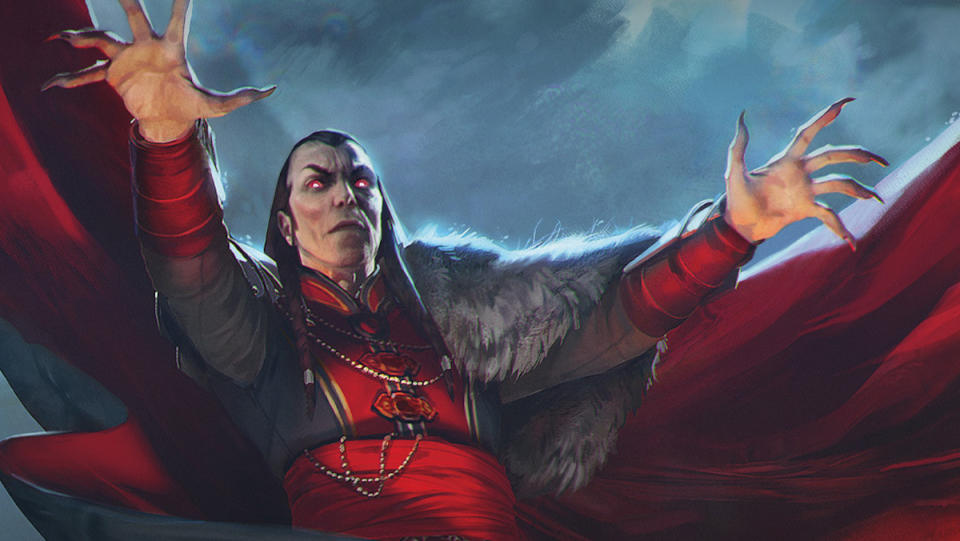How to Play D&D’s New Horror Campaign If You’re a Weenie
You might not think of horror when you think of Dungeons & Dragons, but Wizards of the Coast’s newest campaign integrates the two seamlessly. Van Richten’s Guide to Ravenloft takes Dungeon Masters and their wary players back into Ravenloft to explore new Domains of Dread. Each has its own brand of horror waiting to be unleashed. All your favorite ways to be scared are in this book; it’s got body horror, cosmic horror, zombies, ghosts, and more. You name it, you can play it.
But what if horror isn’t your thing? Does that mean Ravenloft remains forever off-limits? Not at all! Thanks to Van Richten’s project lead and Senior Game Designer Wes Schneider, we’ve got a few tips for how to enter the Domains of Dread so that even the weenies in the adventuring party can have fun.

Wizards of the Coast
Help the DM Scare Your Character
You might think the answer is simple: If you’re scared, don’t play the campaign. But that’s not the case at all, says Wes. His team designed the horror campaign to give Dungeon Masters the freedom to explore scary stories that anyone can enjoy. “[The book] focuses on creating fright-filled adventures that work for your group,” he tells Nerdist. “No matter your group, play styles, or appetite for horror, Van Richten’s Guide sets you up to make D&D frightening however is fun for your group.”
For Dungeons & Dragons players who are, frankly, scared of being scared, Wes recommends working with the Dungeon Master to tell the story together. “Something I love doing in horror games is helping the DM terrify my own character,” he says. “DMs have a lot to keep track of, and so they might not remember that my character has a paralyzing fear of marmots. When the DM announces that the adventure’s mystery heads into menacing caves, I’m sure to ask, ‘Do the caves look marmot-infested?’ Then the DM can decide whether or not to play into my character’s fear. This also provides the DM with a suggestion. If they don’t take it, fine—maybe they’ve got other plans. If they do, though, that’s also fun, and I’ve added a little to the storytelling experience.”

Wizards of the Coast
Talk It Out
While characters should have their own specific fears, Van Richten’s Guide emphasizes that they don’t have match the player’s very real phobias. The book also recommends open communication so that all players feel comfortable at the table.
“A big part of why these discussions are included in the book [is] to support groups in thinking about and discussing what they do and don’t want to see in their adventures,” Wes says. “Nobody gets to tell any group member what they are or aren’t afraid of and what they do or don’t enjoy—not other players, not the DM, not a game designer, not anybody. It’s an entirely personal call and any answer is completely valid. Once all that’s on the table, then prospective players and DMs can decide how to progress.”

Wizards of the Coast
Start with Gothic Horror
Van Richten’s Guide to Ravenloft gives the Dungeon Master the setting and props for the horror story, but it’s up to them for how to tell it. Looking for a Domain of Dread that might be best suited for players not sure they want to be scared? This is a good opportunity to lean into gothic horror.
“If you’d like to get a little distance between your characters and their threats,” Wes suggests, “the book leans into Ravenloft’s gothic horror roots and takes a page from Bram Stoker’s notebook by encouraging groups to engage in correspondence—-maybe between one another or even with sinister forces.”
He adds, “The spiritualists known as the Keepers of the Feather facilitate inter-domain letter delivery, while Darklords like Ivan Dilisnya and Flimira Vhage encourage the creation of letters—potentially even as in-game handouts. I don’t know if that actually makes the experience more or less scary, though: having a Darklord menace characters from afar, or having their threats sitting at your game table. You’ll have to decide what your group enjoys the most!”
Pick Up Van Richten’s Guide Now
Van Richten’s Guide to Ravenloft is packed with so many ideas for exploring the horrors of Ravenloft that it can easily inspire a campaign that lasts for years. Deep dives into new Domains of Dread, new character options including monstrous lineages, new subclasses, an adventure, and more make this book a must-buy for D&D players.
If you’re a weenie who isn’t sure horror is for you (like myself), but you can’t help being drawn to the Mists, this new campaign is the perfect opportunity to safely explore horror with your friends at your side. Find the book now at your favorite local game store.
Featured Image: Wizards of the Coast
Kelly Knox is a freelance entertainment writer in Seattle, WA who writes for Star Wars, DC Comics, and more. Her first book, Marvel Monsters, comes out this July from DK Books. Follow her on Twitter for really bad puns, pop culture coverage, and more.
The post How to Play D&D’s New Horror Campaign If You’re a Weenie appeared first on Nerdist.

